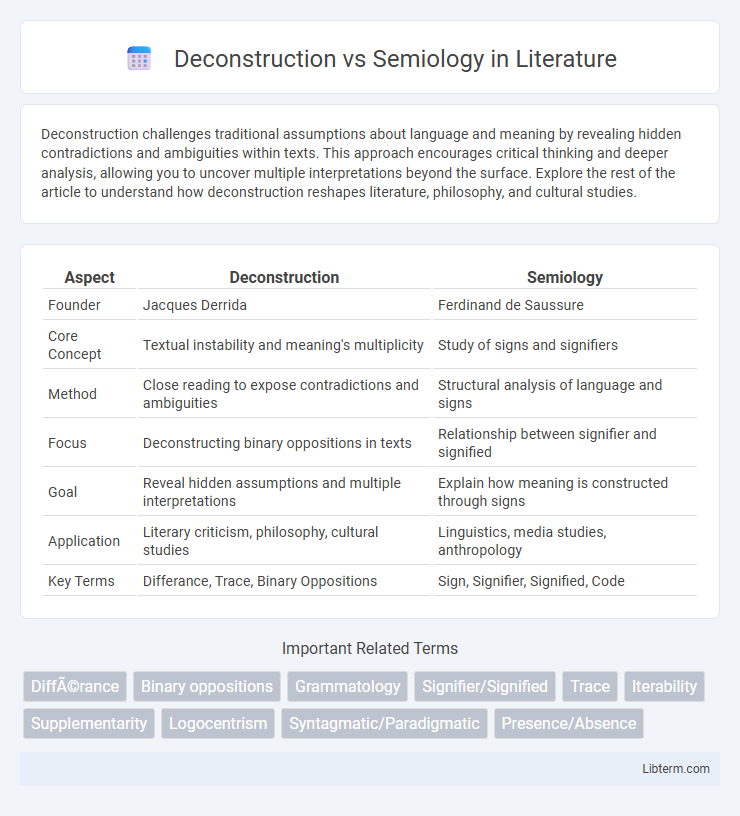Deconstruction challenges traditional assumptions about language and meaning by revealing hidden contradictions and ambiguities within texts. This approach encourages critical thinking and deeper analysis, allowing you to uncover multiple interpretations beyond the surface. Explore the rest of the article to understand how deconstruction reshapes literature, philosophy, and cultural studies.
Table of Comparison
| Aspect | Deconstruction | Semiology |
|---|---|---|
| Founder | Jacques Derrida | Ferdinand de Saussure |
| Core Concept | Textual instability and meaning's multiplicity | Study of signs and signifiers |
| Method | Close reading to expose contradictions and ambiguities | Structural analysis of language and signs |
| Focus | Deconstructing binary oppositions in texts | Relationship between signifier and signified |
| Goal | Reveal hidden assumptions and multiple interpretations | Explain how meaning is constructed through signs |
| Application | Literary criticism, philosophy, cultural studies | Linguistics, media studies, anthropology |
| Key Terms | Differance, Trace, Binary Oppositions | Sign, Signifier, Signified, Code |
Introduction to Deconstruction and Semiology
Deconstruction, pioneered by Jacques Derrida, challenges traditional structures by exposing inherent contradictions within texts, emphasizing the fluidity of meaning. Semiology, based on Ferdinand de Saussure's linguistic theories, studies signs and symbols as fundamental units of communication that convey meaning through their relationship within a system. Both approaches critically analyze language, with deconstruction focusing on instability and ambiguity, while semiology decodes fixed signifier-signified relationships in cultural texts.
Historical Origins of Deconstruction
Deconstruction originated in the late 1960s through the work of French philosopher Jacques Derrida, who challenged traditional Western metaphysics and structuralist linguistics by questioning the stability of meaning in texts. It emerged as a critical response to semiology, which studies the structure of signs and symbols based on Ferdinand de Saussure's early 20th-century theories. While semiology emphasizes fixed signifier-signified relationships, deconstruction reveals the inherent contradictions and fluidity within language, destabilizing established interpretations.
Emergence and Foundations of Semiology
The emergence of semiology, founded by Ferdinand de Saussure, centers on the systematic study of signs and their relational structures within language, emphasizing the arbitrariness and dual components of signifier and signified. Deconstruction, developed by Jacques Derrida, challenges the fixed binary oppositions in semiology, exposing inherent ambiguities and the fluidity of meaning through iterative processes of differance. Semiology establishes foundational principles of sign systems, while deconstruction critiques and destabilizes these foundations, revealing how meaning continuously emerges and evolves beyond stable sign structures.
Key Philosophers: Derrida vs. Saussure
Jacques Derrida's deconstruction challenges Ferdinand de Saussure's semiology by critiquing the stability of linguistic signs and emphasizing the inherent ambiguity in language structures. Saussure established the foundation of semiology by defining the sign as a combination of the signifier and signified, promoting structuralism in understanding language systems. Derrida's work problematizes this binary opposition, asserting that meaning is always deferred through endless differences, which destabilizes Saussurean concepts of fixed meanings.
Central Concepts: Meaning and Structure
Deconstruction challenges the fixed meaning of texts by exposing inherent contradictions and the instability of language, emphasizing the fluidity of meaning and the interplay of binary oppositions. Semiology, rooted in Ferdinand de Saussure's structuralism, analyzes signs through the relationship between the signifier and the signified, focusing on the underlying structures that produce meaning within language systems. While semiology seeks to identify stable structures governing meaning, deconstruction reveals the limitations of these structures, highlighting the dynamic and contested nature of textual interpretation.
Language, Signs, and Representation
Deconstruction challenges traditional notions of language by exposing inherent ambiguities and contradictions within signs, revealing that meaning is unstable and constantly deferred. Semiology, founded by Ferdinand de Saussure, analyzes language as a system of signs consisting of the signifier (sound/image) and the signified (concept), emphasizing the arbitrary relationship between them and structured representation. While semiology seeks to categorize and decode signs' meanings within cultural contexts, deconstruction destabilizes these meanings, highlighting the fluidity and multiplicity inherent in representation.
Methods of Analysis in Deconstruction
Deconstruction employs a method of analysis that interrogates texts by exposing internal contradictions, ambiguities, and the instability of meaning. This approach challenges hierarchical oppositions and binary structures within language, revealing how meaning is deferred through the play of differences. Unlike semiology, which decodes signs within a structured system, deconstruction destabilizes signifiers to uncover latent interpretations and the impossibility of fixed meaning.
Approaches to Textual Interpretation in Semiology
Semiology analyzes texts by examining signs, symbols, and cultural codes to uncover meaning rooted in societal structures and communication systems. It prioritizes the relationship between signifiers and the signified, emphasizing how meaning is constructed through linguistic and cultural conventions. This approach contrasts with deconstruction, which seeks to expose inherent contradictions and the instability of meaning within the text itself.
Points of Convergence and Divergence
Deconstruction and semiology converge in their focus on language as an unstable system of signs where meaning is not fixed but perpetually deferred, challenging traditional notions of absolute interpretation. They diverge in methodology: deconstruction, pioneered by Jacques Derrida, emphasizes the inherent contradictions and ambiguities within texts to reveal hidden assumptions and instabilities, while semiology, founded by Ferdinand de Saussure, analyzes signs through the structured relationship between the signifier and signified within a linguistic system. Both approaches critically interrogate meaning, but deconstruction destabilizes binary oppositions, whereas semiology seeks to map the systematic structures underlying meaning production.
Impact on Contemporary Literary and Cultural Theory
Deconstruction challenges traditional binary oppositions in texts by exposing inherent contradictions and ambiguities, fundamentally reshaping contemporary literary criticism and cultural theory through its emphasis on the instability of meaning. Semiology, rooted in the study of signs and symbols, provides tools for decoding cultural narratives and the systems of representation that construct social realities, influencing structuralist and post-structuralist approaches. Both frameworks have significantly impacted contemporary theory by encouraging critical analysis of language, power structures, and the construction of identity within texts and cultural practices.
Deconstruction Infographic

 libterm.com
libterm.com